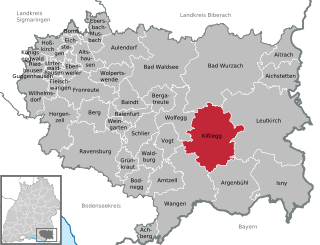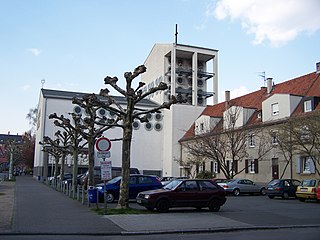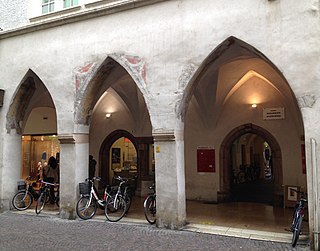
Nuremberg is the second-largest city of the German state of Bavaria after its capital Munich, and its 518,370 (2019) inhabitants make it the 14th-largest city in Germany. On the Pegnitz River and the Rhine–Main–Danube Canal, it lies in the Bavarian administrative region of Middle Franconia, and is the largest city and the unofficial capital of Franconia. Nuremberg forms a continuous conurbation with the neighbouring cities of Fürth, Erlangen and Schwabach with a total population of 800,376 (2019), while the larger Nuremberg Metropolitan Region has approximately 3.6 million inhabitants. The city lies about 170 kilometres (110 mi) north of Munich. It is the largest city in the East Franconian dialect area.

Louis IV, called the Bavarian, of the house of Wittelsbach, was King of the Romans from 1314, King of Italy from 1327, and Holy Roman Emperor from 1328.

The Imperial Crown of the Holy Roman Empire, a hoop crown with a characteristic octagonal shape, was the coronation crown of the Holy Roman Emperor, probably from the late 10th century until the dissolution of the Holy Roman Empire in 1806. The crown was used in the coronation of the King of the Romans, the title assumed by the Emperor-elect immediately after his election. It is now kept in the Imperial Treasury at the Hofburg in Vienna, Austria.

The Austrian Crown Jewels is the regalia and vestments worn by the Holy Roman Emperor, and later by the Emperor of Austria, during the coronation ceremony and other state functions. The term refers to the following objects: the crowns, sceptres, orbs, swords, rings, crosses, holy relics, and the royal robes, as well as several other objects connected with the ceremony. The collection dates from the 10th to the 19th centuries and reflects more than a thousand years of European history. It is kept at the Imperial Treasury in the Hofburg Palace in Vienna, Austria.

The Imperial Regalia, also Imperial Insignia, are regalia of the Holy Roman Emperor. The most important parts are the Imperial Crown, the Imperial orb, the Imperial sceptre, the Holy Lance and the Imperial Sword. Today they are kept at the Imperial Treasury in the Hofburg palace in Vienna, Austria.

Markgröningen is a town in the district (Kreis) of Ludwigsburg, Baden-Württemberg, Germany. It is known for its fine historic buildings, many in the Fachwerk German architectural style, and its annual Shepherds' Run. Markgröningen is on the Deutsche Fachwerkstraße.

Kißlegg (Kisslegg) is a town in the district of Ravensburg in Baden-Württemberg in Germany. Kißlegg is not far from the village of Vogt. It has a beautiful church, rich in culture and beauty.

The Holy Cross Church is a Catholic church in the Bornheim district of Frankfurt am Main (Germany). It is similar in design to the Frauenfriedenskirche in Frankfurt-Bockenheim. It was built by Martin Weber from 1928 to 1929, on a rise then known as Bornheimer Hang. The church is an unusual example of interwar modernism as sacred Bauhaus architecture.

The Frauenkirche is a church in Nuremberg, Germany. It stands on the eastern side of the main market. An example of brick Gothic architecture, it was built on the initiative of Charles IV, Holy Roman Emperor between 1352 and 1362. The church contains many sculptures, some of them heavily restored. Numerous works of art from the Middle Ages are kept in the church, such as the so-called Tucher Altar, and two monuments by Adam Kraft.

Freiburg Charterhouse is a former Carthusian monastery, or charterhouse, in Freiburg im Breisgau, Baden-Württemberg, Germany.

The Spitalgasse is one of the streets in the Old City of Bern, the medieval city center of Bern, Switzerland. It is part of the Äussere Neustadt which was built during the third expansion from 1344 to 1346. The eastern end is at Waisenhausplatz and Bärenplatz while the western end is at Bahnhofplatz near the Church of the Holy Ghost. It is part of the UNESCO Cultural World Heritage Site that encompasses the Old City.

The Imperial Treasury at the Hofburg Palace in Vienna, Austria contains a valuable collection of secular and ecclesiastical treasures covering over a thousand years of European history. The entrance to the treasury is at the Schweizerhof, the oldest part of the palace, which was rebuilt in the sixteenth century in the Renaissance style under Holy Roman Emperor Ferdinand I. The Imperial Treasury is affiliated with the Kunsthistorisches Museum, and houses in 21 rooms a collection of rare treasures that were compiled by the Imperial House of Habsburg over the course of centuries, including the Imperial Crown, Orb, and Sceptre of Austria, and the Imperial Regalia of the Emperors and Kings of the Holy Roman Empire, including the Imperial Crown of the Holy Roman Empire.

The Imperial City of Nuremberg was a free imperial city — independent city-state — within the Holy Roman Empire. After Nuremberg gained piecemeal independence from the Burgraviate of Nuremberg in the High Middle Ages and considerable territory from Bavaria in the Landshut War of Succession, it grew to become one of the largest and most important Imperial cities, the 'unofficial capital' of the Empire, particularly because numerous Imperial Diets and courts met at Nuremberg Castle between 1211 an 1543. Because of the many Diets of Nuremberg Nuremberg became an important routine place of the administration of the Empire during this time. The Golden Bull of 1356, issued by Emperor Charles IV, named Nuremberg as the city where newly elected kings of Germany must hold their first Imperial Diet, making Nuremberg one of the three highest cities of the Empire.

The Imhoff, Imhof or Im Hof family is a noble patrician family that belonged to the wealthy trading dynasties and ruling oligarchy in the Free Imperial City of Nuremberg during its Golden Age in the Renaissance. The Imhoff Trading Company was one of the most important European traders between the 15th and 17th centuries. It maintained branches and trade connections throughout Europe and financed European courts with loans.

The so-called Sabre of Charlemagne is an early sabre of Hungarian (Magyar) type which has exceptionally been preserved as part of the Aachen regalia of the Holy Roman Empire. Along with the rest of the imperial regalia from both Aachen and Nuremberg, it is now kept in the Hofburg Palace, Vienna.

The Bürgerspital zum Heiligen Geist is a Stiftung foundation in Würzburg. It operates several senior citizens' homes and geriatric rehabilitation clinic. The economic foundation of the Stiftung foundation is the extensive properties and the winery, which today is one of the oldest and largest German vineyards. A wine tavern in Würzburg's old town with a restaurant, which offers wines from the Bürgerspital and Franconian breads, is also part of the establishment.

Heilig Geist is the name of a Catholic church in the suburb Riederwald of Frankfurt am Main, Hesse, Germany. The parish church of the Riederwald congregation is part of the Roman Catholic Diocese of Limburg. On 1 January 2015 the parish became a Kirchort, part of the parish St. Josef, Frankfurt.

The Civic Archives in Bozen-Bolzano are the municipal archive of the city of Bolzano in South Tyrol, Italy. They are located in the old town hall and store documents from over 700 years of civic and regional history.

The Holy Spirit Hospital (Berlin) (Heilig-Geist-Spital) was one of the earliest hospitals in Berlin, established in 1250. It was located on the western side of Spandauer Straße.




















